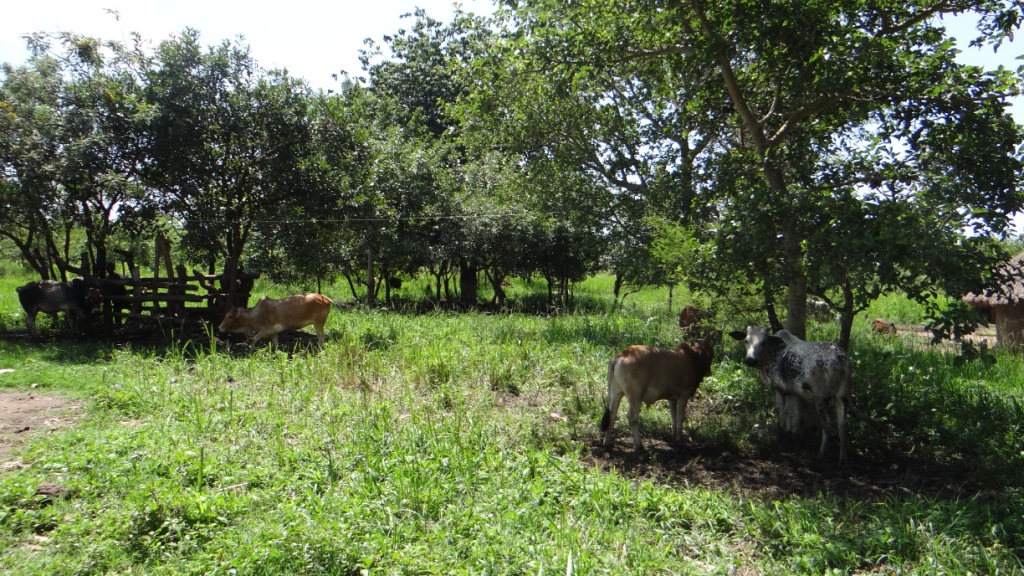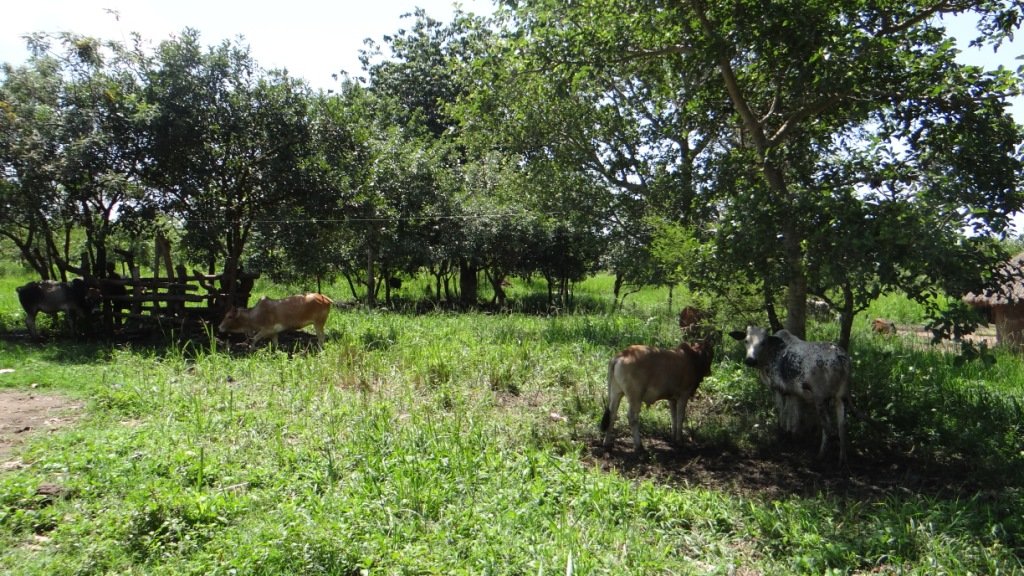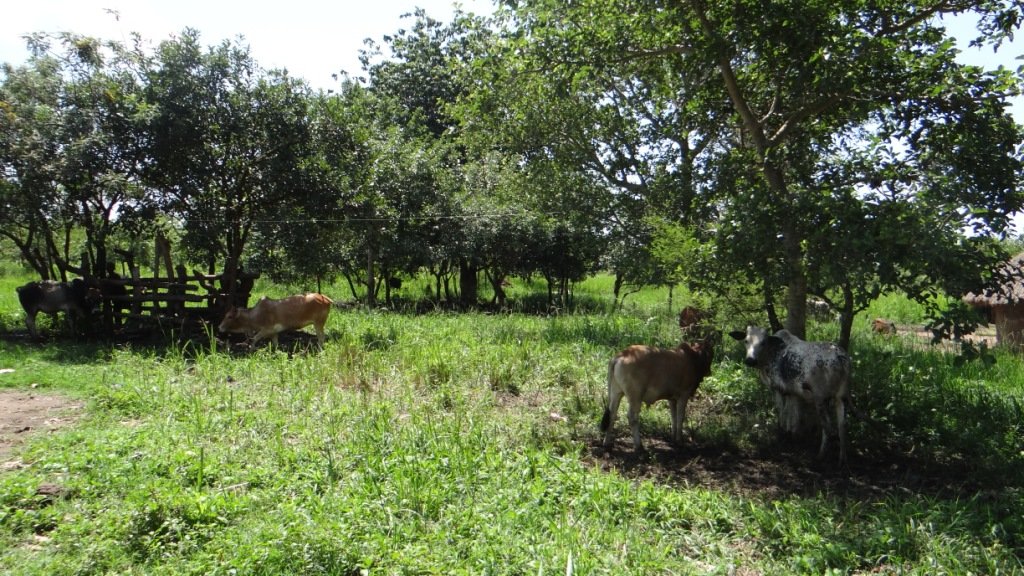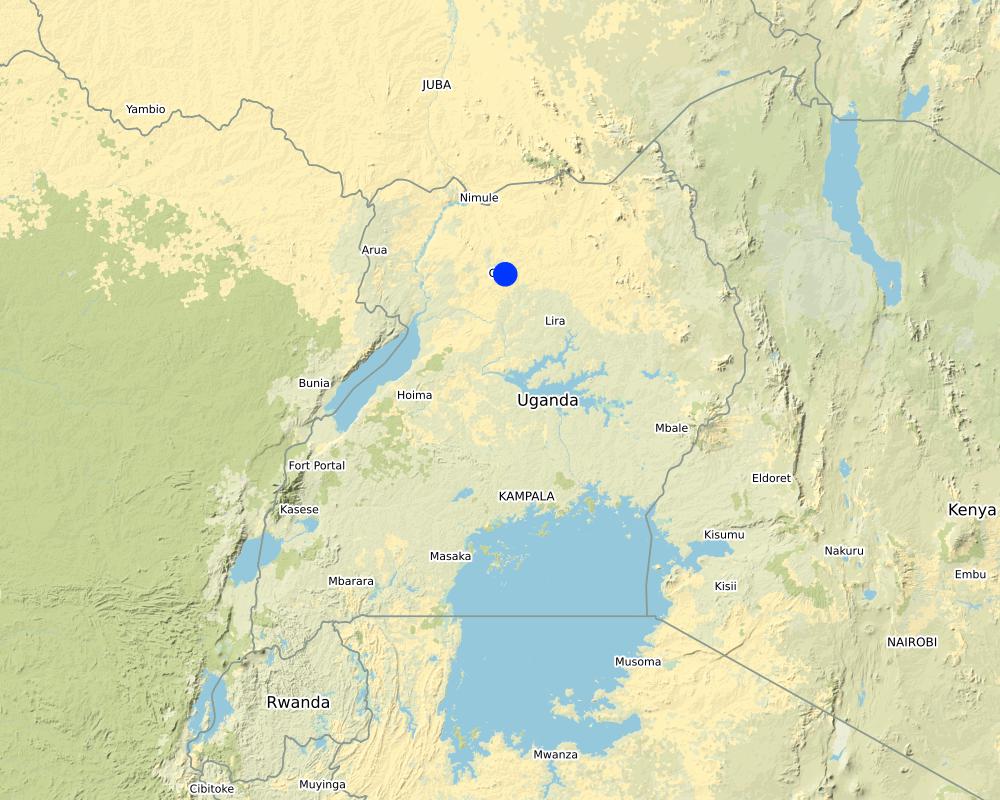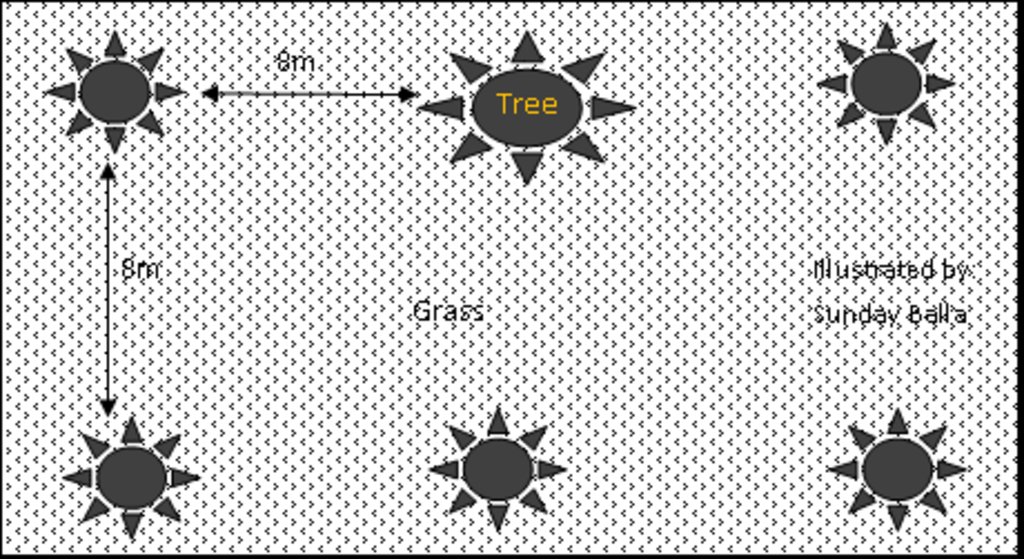Multi-Purpose Tree Species for Pasture Supplementation [Uganda]
- Creation:
- Update:
- Compiler: Sunday Balla Amale
- Editors: JOY TUKAHIRWA, Kamugisha Rick Nelson
- Reviewers: John Stephen Tenywa, Udo Höggel
pito yat ma lee chamo
technologies_3328 - Uganda
View sections
Expand all Collapse all1. General information
1.2 Contact details of resource persons and institutions involved in the assessment and documentation of the Technology
Name of project which facilitated the documentation/ evaluation of the Technology (if relevant)
Scaling-up SLM practices by smallholder farmers (IFAD)Name of the institution(s) which facilitated the documentation/ evaluation of the Technology (if relevant)
Makerere University (Makerere University) - Uganda1.3 Conditions regarding the use of data documented through WOCAT
When were the data compiled (in the field)?
12/12/2017
The compiler and key resource person(s) accept the conditions regarding the use of data documented through WOCAT:
Yes
1.4 Declaration on sustainability of the described Technology
Is the Technology described here problematic with regard to land degradation, so that it cannot be declared a sustainable land management technology?
No
1.5 Reference to Questionnaire(s) on SLM Approaches
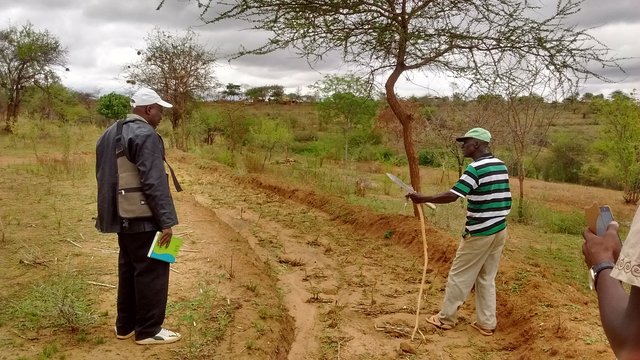
On-farm indigenous pasture establishment demonstrations [Kenya]
On-farm indigenous pasture establishment demonstrations offer a practical approach to encourage adoption in the arid and semi-arid environments in Kenya.
- Compiler: Kevin Mganga
2. Description of the SLM Technology
2.1 Short description of the Technology
Definition of the Technology:
Multi-purpose tree species such as Calliandra calothyrsus are planted on farmstead to improve pastures for soil fertility improvement and livestock production
2.2 Detailed description of the Technology
Description:
Livestock keepers in Northern Uganda face challenges of obtaining pasture for their animals due to land fragmentation, conflicts and bush burning. Cattle keepers in Nwoya District now plant multi-purpose trees to enrich the existing livestock pastures with the aim of increasing productivity per unit area of available land.
Multi-purpose tree seedlings, cuttings or seeds such as Calliandra calothyrsus are planted in natural pasture land at a spacing of about 8m x 8m. Depending on the shape of the trees, the spacing can be wider or narrower. The growing trees are caged during the first year of growth to prevent the animals from feeding on them and ensure proper establishment. In the following year after planting, trees can be used for feeding the livestock. In the first 3 years, the tree leaves can be cut and carried to the livestock as the trees are still tender and susceptible to overgrazing. Thereafter, trees can be directly browsed by the animals until a period when trees will have grown higher than the animals can reach; then again leaves are cut and carried to the livestock or pruned to a suitable height.
The trees produce nutritious leaves, among other products, used as livestock feed to supplement animal pasture. Furthermore, the trees provide shade for the animals during hot days. The leguminous trees bear vegetation rich in protein content, are evergreen and produce leaves throughout the year, hence, serve as an important source of feed during dry season when grass is dry or burnt. Animals produce good quality manure that can be used for improving soil fertility. The availability of leguminous trees in the pasture land also prevents overgrazing of the grass and therefore, incidences of soil erosion is minimized.
2.3 Photos of the Technology
2.4 Videos of the Technology
Date:
12/12/2017
Location:
Gulu District, Northern Uganda
Name of videographer:
Isa Aiga
2.5 Country/ region/ locations where the Technology has been applied and which are covered by this assessment
Country:
Uganda
Region/ State/ Province:
Northern Region,Uganda
Further specification of location:
Gulu District
Map
×2.6 Date of implementation
Indicate year of implementation:
2008
2.7 Introduction of the Technology
Specify how the Technology was introduced:
- through land users' innovation
- through projects/ external interventions
Comments (type of project, etc.):
Land users were trained on agro-forestry practices through projects. Lateron land users incorporated multipurpose trees into their farming system.
3. Classification of the SLM Technology
3.1 Main purpose(s) of the Technology
- improve production
- reduce, prevent, restore land degradation
- preserve/ improve biodiversity
- adapt to climate change/ extremes and its impacts
- create beneficial economic impact
3.2 Current land use type(s) where the Technology is applied

Grazing land
- tethering domestic animals
Main animal species and products:
Cattle, goats and sheep
3.3 Further information about land use
Water supply for the land on which the Technology is applied:
- rainfed
Number of growing seasons per year:
- 2
Livestock density (if relevant):
8 animals kept near the homestead
3.4 SLM group to which the Technology belongs
- pastoralism and grazing land management
- integrated crop-livestock management
3.5 Spread of the Technology
Specify the spread of the Technology:
- applied at specific points/ concentrated on a small area
3.6 SLM measures comprising the Technology

agronomic measures
- A1: Vegetation/ soil cover

vegetative measures
- V2: Grasses and perennial herbaceous plants
3.7 Main types of land degradation addressed by the Technology

soil erosion by water
- Wg: gully erosion/ gullying

soil erosion by wind
- Et: loss of topsoil

chemical soil deterioration
- Cn: fertility decline and reduced organic matter content (not caused by erosion)

physical soil deterioration
- Pc: compaction
- Ps: subsidence of organic soils, settling of soil

biological degradation
- Bc: reduction of vegetation cover
- Bh: loss of habitats
- Bq: quantity/ biomass decline
Comments:
Trees increase vegetation cover thus controls surface erosion by wind. Tree roots bind soil particles together reducing surface runoff and the creation of gullies. The trees are leguminous and therefore leaves and animal dung are rich in nitrogen. Tree roots reduce the effect of over-compaction of soil by livestock.
3.8 Prevention, reduction, or restoration of land degradation
Specify the goal of the Technology with regard to land degradation:
- reduce land degradation
- adapt to land degradation
Comments:
Livestock kept on a small piece of land can result in over-grazing and create land degradation. Incorporation of trees help to counter this effect.
4. Technical specifications, implementation activities, inputs, and costs
4.1 Technical drawing of the Technology
4.2 Technical specifications/ explanations of technical drawing
Trees are planted at a spacing of about 8 m x 8 m in the grazing land on a gentle sloping area
4.3 General information regarding the calculation of inputs and costs
Specify how costs and inputs were calculated:
- per Technology area
Indicate size and area unit:
1 acre of grazing land
other/ national currency (specify):
Uganda shillings
Indicate exchange rate from USD to local currency (if relevant): 1 USD =:
3600.0
Indicate average wage cost of hired labour per day:
5000
4.4 Establishment activities
| Activity | Type of measure | Timing | |
|---|---|---|---|
| 1. | Sourcing seed of multipurpose trees | Management | dry season |
| 2. | Digging the holes for planting | Structural | onset of rains |
| 3. | Planting seeds | Agronomic | early rainy season |
| 4. | Protecting young trees from destruction | Structural | during growth periods |
4.5 Costs and inputs needed for establishment
| Specify input | Unit | Quantity | Costs per Unit | Total costs per input | % of costs borne by land users | |
|---|---|---|---|---|---|---|
| Labour | Personnel | persondays | 4.0 | 5000.0 | 20000.0 | 100.0 |
| Equipment | Hand hoe | pieces | 1.0 | 10000.0 | 10000.0 | 100.0 |
| Equipment | Tape measure | pieces | 1.0 | 5000.0 | 5000.0 | 100.0 |
| Plant material | Seeds | kg | 0.5 | 40000.0 | 20000.0 | 100.0 |
| Total costs for establishment of the Technology | 55000.0 | |||||
4.6 Maintenance/ recurrent activities
Comments:
No need for maintenance. Reseeding may be considered after 15-20 years
4.7 Costs and inputs needed for maintenance/ recurrent activities (per year)
Comments:
No cost since cutting the tree branches triggers the regrowth of leaves and branches
4.8 Most important factors affecting the costs
Describe the most determinate factors affecting the costs:
Labour for planting
5. Natural and human environment
5.1 Climate
Annual rainfall
- < 250 mm
- 251-500 mm
- 501-750 mm
- 751-1,000 mm
- 1,001-1,500 mm
- 1,501-2,000 mm
- 2,001-3,000 mm
- 3,001-4,000 mm
- > 4,000 mm
Specify average annual rainfall (if known), in mm:
1000.00
Indicate the name of the reference meteorological station considered:
Gulu meteorological station
Agro-climatic zone
- sub-humid
5.2 Topography
Slopes on average:
- flat (0-2%)
- gentle (3-5%)
- moderate (6-10%)
- rolling (11-15%)
- hilly (16-30%)
- steep (31-60%)
- very steep (>60%)
Landforms:
- plateau/plains
- ridges
- mountain slopes
- hill slopes
- footslopes
- valley floors
Altitudinal zone:
- 0-100 m a.s.l.
- 101-500 m a.s.l.
- 501-1,000 m a.s.l.
- 1,001-1,500 m a.s.l.
- 1,501-2,000 m a.s.l.
- 2,001-2,500 m a.s.l.
- 2,501-3,000 m a.s.l.
- 3,001-4,000 m a.s.l.
- > 4,000 m a.s.l.
Indicate if the Technology is specifically applied in:
- not relevant
5.3 Soils
Soil depth on average:
- very shallow (0-20 cm)
- shallow (21-50 cm)
- moderately deep (51-80 cm)
- deep (81-120 cm)
- very deep (> 120 cm)
Soil texture (topsoil):
- medium (loamy, silty)
Soil texture (> 20 cm below surface):
- medium (loamy, silty)
Topsoil organic matter:
- medium (1-3%)
5.4 Water availability and quality
Ground water table:
5-50 m
Availability of surface water:
medium
Water quality (untreated):
poor drinking water (treatment required)
Is water salinity a problem?
No
Is flooding of the area occurring?
No
5.5 Biodiversity
Species diversity:
- low
Habitat diversity:
- low
5.6 Characteristics of land users applying the Technology
Sedentary or nomadic:
- Sedentary
Market orientation of production system:
- mixed (subsistence/ commercial
Off-farm income:
- less than 10% of all income
Relative level of wealth:
- average
Individuals or groups:
- individual/ household
Level of mechanization:
- manual work
- animal traction
Gender:
- women
- men
Age of land users:
- youth
- middle-aged
5.7 Average area of land owned or leased by land users applying the Technology
- < 0.5 ha
- 0.5-1 ha
- 1-2 ha
- 2-5 ha
- 5-15 ha
- 15-50 ha
- 50-100 ha
- 100-500 ha
- 500-1,000 ha
- 1,000-10,000 ha
- > 10,000 ha
Is this considered small-, medium- or large-scale (referring to local context)?
- small-scale
5.8 Land ownership, land use rights, and water use rights
Land ownership:
- individual, titled
Land use rights:
- communal (organized)
- for grazing area
Water use rights:
- open access (unorganized)
5.9 Access to services and infrastructure
health:
- poor
- moderate
- good
education:
- poor
- moderate
- good
technical assistance:
- poor
- moderate
- good
employment (e.g. off-farm):
- poor
- moderate
- good
markets:
- poor
- moderate
- good
energy:
- poor
- moderate
- good
roads and transport:
- poor
- moderate
- good
drinking water and sanitation:
- poor
- moderate
- good
financial services:
- poor
- moderate
- good
6. Impacts and concluding statements
6.1 On-site impacts the Technology has shown
Socio-economic impacts
Production
fodder production
Comments/ specify:
Animal have enough feed
fodder quality
Comments/ specify:
Leguminous multi-purpose tree leaves have high protein content
animal production
Quantity before SLM:
4
Quantity after SLM:
6
wood production
Comments/ specify:
Trees branches used as firewood
risk of production failure
Comments/ specify:
Usually higher production
land management
Comments/ specify:
Reduced erosion and trampling
Income and costs
farm income
Quantity before SLM:
3litre/day
Quantity after SLM:
5litre/day
Comments/ specify:
Higher milk production during peak of lactation.
workload
Comments/ specify:
The time / workload to activily graze animals is reduced due to the presence of trees
Socio-cultural impacts
food security/ self-sufficiency
Comments/ specify:
Increased milk production
health situation
Comments/ specify:
Through increased consumption of milk
land use/ water rights
Comments/ specify:
Farmers learned how to manage their land in a proper way
national institutions
Comments/ specify:
Institution of research and policy uses information from farmers about multi-purpose trees
SLM/ land degradation knowledge
conflict mitigation
Comments/ specify:
Animals used to destroy other people's fields looking for pasture
Ecological impacts
Soil
soil moisture
Comments/ specify:
Leaves act as mulch on the soil surface thus retaining water. Leaves increase humus thus increasing the water holding capacity of soil
soil cover
Comments/ specify:
Tree canopy and fallen leaves improves soil cover.
soil loss
Comments/ specify:
Reduced surface runoff which causes soil loss
soil crusting/ sealing
Comments/ specify:
soil surface is covered with decomposing leaves hence reduces sealing.
soil compaction
Comments/ specify:
Reduced grazing reduces soil compaction by animals
nutrient cycling/ recharge
Comments/ specify:
Tree roots bring to surface leached nutrients
soil organic matter/ below ground C
Comments/ specify:
Tree leaves and roots decompose to add organic matter to soil
acidity
Comments/ specify:
humus reduces soil acidity
Biodiversity: vegetation, animals
Vegetation cover
biomass/ above ground C
plant diversity
Comments/ specify:
Grass and trees presence increased
Climate and disaster risk reduction
drought impacts
Comments/ specify:
Trees are ever green even during dry periods when pasture are burnt or dried up
wind velocity
Comments/ specify:
Trees act as wind breaks
micro-climate
Comments/ specify:
Trees act as shade for livestock
6.2 Off-site impacts the Technology has shown
groundwater/ river pollution
Comments/ specify:
Trees cover reduce surface runoff which carries pollutants such as animal dung into water sources. Leaves help filtering ground water.
damage on neighbours' fields
Comments/ specify:
Less livestock movement / trampling on neighbouting fields
6.3 Exposure and sensitivity of the Technology to gradual climate change and climate-related extremes/ disasters (as perceived by land users)
Gradual climate change
Gradual climate change
| Season | Type of climatic change/ extreme | How does the Technology cope with it? | |
|---|---|---|---|
| annual rainfall | decrease | very well | |
| seasonal rainfall | dry season | decrease | very well |
Climate-related extremes (disasters)
Climatological disasters
| How does the Technology cope with it? | |
|---|---|
| drought | very well |
6.4 Cost-benefit analysis
How do the benefits compare with the establishment costs (from land users’ perspective)?
Short-term returns:
slightly negative
Long-term returns:
very positive
How do the benefits compare with the maintenance/ recurrent costs (from land users' perspective)?
Short-term returns:
slightly positive
Long-term returns:
very positive
6.5 Adoption of the Technology
- 1-10%
Of all those who have adopted the Technology, how many have did so spontaneously, i.e. without receiving any material incentives/ payments?
- 0-10%
Comments:
Adoption is a process and this project was implemented for three years; within this period the farmers who spontaneously adopted the technology were very few.
6.6 Adaptation
Has the Technology been modified recently to adapt to changing conditions?
No
6.7 Strengths/ advantages/ opportunities of the Technology
| Strengths/ advantages/ opportunities in the land user’s view |
|---|
| It is cheap to establish |
| Does not require maintenance |
| Produces pasture throughout the year |
| Strengths/ advantages/ opportunities in the compiler’s or other key resource person’s view |
|---|
| Produces good quality pasture high in protein content |
| Animals produce good quality manure which can be applied in crop fields |
6.8 Weaknesses/ disadvantages/ risks of the Technology and ways of overcoming them
| Weaknesses/ disadvantages/ risks in the land user’s view | How can they be overcome? |
|---|---|
| Trees take almost a year to grow and able to be used for feeding animals |
7. References and links
7.1 Methods/ sources of information
- interviews with land users
1
- compilation from reports and other existing documentation
1
7.2 References to available publications
Title, author, year, ISBN:
Feedipedia
Available from where? Costs?
https://www.feedipedia.org/node/586
7.3 Links to relevant information which is available online
Title/ description:
Calliandra for livestock
URL:
http://old.worldagroforestry.org/Units/Library/Books/PDFs/98_Calliandra_for_livestock.pdf
Links and modules
Expand all Collapse allLinks

On-farm indigenous pasture establishment demonstrations [Kenya]
On-farm indigenous pasture establishment demonstrations offer a practical approach to encourage adoption in the arid and semi-arid environments in Kenya.
- Compiler: Kevin Mganga
Modules
No modules


